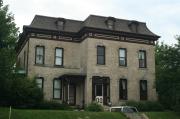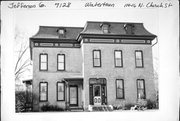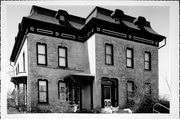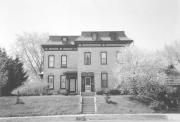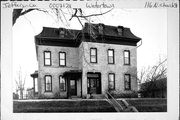Property Record
114-116 N CHURCH ST
Architecture and History Inventory
| Historic Name: | Dr. James Cody House |
|---|---|
| Other Name: | |
| Contributing: | Yes |
| Reference Number: | 7128 |
| Location (Address): | 114-116 N CHURCH ST |
|---|---|
| County: | Jefferson |
| City: | Watertown |
| Township/Village: | |
| Unincorporated Community: | |
| Town: | |
| Range: | |
| Direction: | |
| Section: | |
| Quarter Section: | |
| Quarter/Quarter Section: |
| Year Built: | 1877 |
|---|---|
| Additions: | |
| Survey Date: | 2004 |
| Historic Use: | house |
| Architectural Style: | Second Empire |
| Structural System: | Masonry |
| Wall Material: | Cream Brick |
| Architect: | |
| Other Buildings On Site: | |
| Demolished?: | No |
| Demolished Date: |
| National/State Register Listing Name: | North Washington Street Historic District |
|---|---|
| National Register Listing Date: | 10/23/2009 |
| State Register Listing Date: | 4/17/2009 |
| National Register Multiple Property Name: |
| Additional Information: | "Open screened porch on north wing with Tuscan columns and balustrade; projecting wooden triangular shaped window and door heads; entrance door into main block with over light; oculus in front gable; moulded window hoods." (From the hestern Historical Co., 1879, p. 602.) This house was the home of Dr. James Cody. Cody's son William G. lived here between the late nineteenth century to at least 1930. James Cody was born in Newfoundland. He studied medicine in Massachusetts, receiving his medical degree in 1844 from Harvard University. He came to Watertown in 1846 and practiced there beginning at that time. His activities beyond his local medical practice included time as Surgeon of the Wisconsin State Artillery, an Examiner of Pensions for the U.S. Government, and a school superintendent. He was known as a civic leader as well as physician. This house is significant for local history under National Register criterion B, because it is associated with Dr. James Cody. Cody was probably the most noted of Watertown's pioneer doctors. He was well-trained for an early Wisconsin doctor and identified himself as an electic physician and surgeon. Cody was probably the most well-known of all the early doctors in the community. And, his activities outside of his local practice made a larger impact on the community than others. Because of his importance in the history of medicine in Watertown, Cody is a significant early citizen of the community. Cody had offices in Watertown's downtown commercial district, for a time in the prestigious Bank of Watertown building. However, this house was his long time home and has historical significance because of it. Distinguished by a mansard roof with concave sides and arched dormers, this house built for Dr. James Cody features raised stone widow hoods with articulated keystones placed over arched one over one windows and a similarly styled door hood placed over the sidelighted door and transom window on the facade of the main block. The letter "C" can be seen in the keystone over the front door. An open one-bay porch leads to the arched entrance door on the south wing, a mansard roofed bay window on the south elevation and a paneled frieze under the overhanging eaves or cornice further characterize the house. Notable interior features include a wide curving stairway with walnut handrail and spindles, plaster ceiling medallions, marble fireplace and sliding doors. The removal of the Italianate brackets and dentils from thr cornice under the eaves has altered the exterior appearance of the house. The James Cody house is significant under criterion C as a good example of the French Second Empire style. Among the most significant of the seven extent examples in the city, the Cody house exhibits the distinguishing characteristics of the style including the mansard roof and arched dormers, projecting pavilion, and arched windows with decorative hoods. Italianate influences include the overhanging eaves, articulated arch window hood and interior ornament such as plaster cornices and medallion. Other significant examples of the Second Empire style in the city inculde the Stone house at 300 So. Washington (54-36), the Mulberger house at 311 So. Washington (54-32), the Globe Milling house at 623 So. 12th (35-30) and the Werlich house at 719 Market (45-22). House at 719 Market (45-22). |
|---|---|
| Bibliographic References: | "A New Residence," Watertown Democrat, 15 February 1877. Follow-up mention on 3 May 1877. “Architecture/History Survey: Reconstruct STH 26 (Church St.): STH 19 To Union Pacific RR.” WHS project number 04-0759/DO/JE. February 2004. Prepared by Carol Cartwright. |
| Wisconsin Architecture and History Inventory, State Historic Preservation Office, Wisconsin Historical Society, Madison, Wisconsin |

